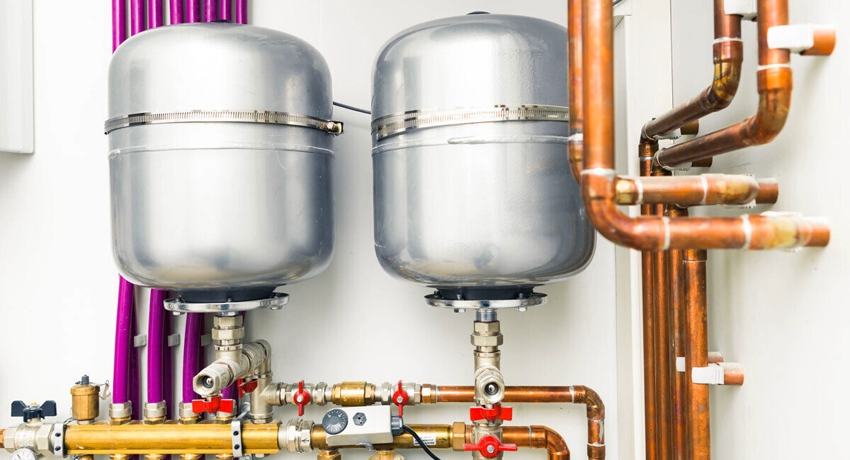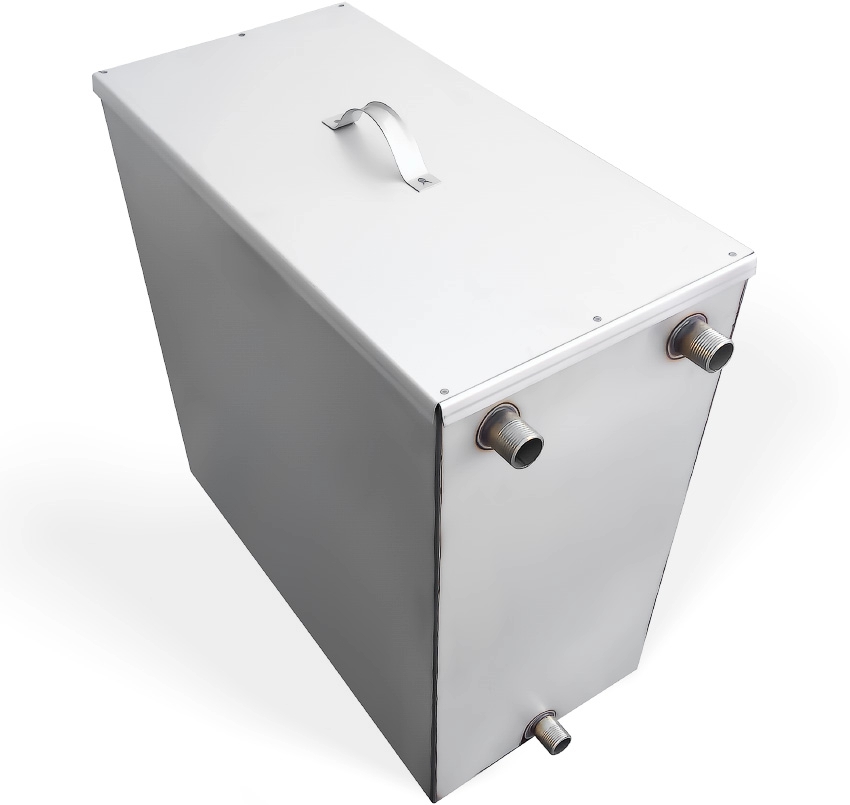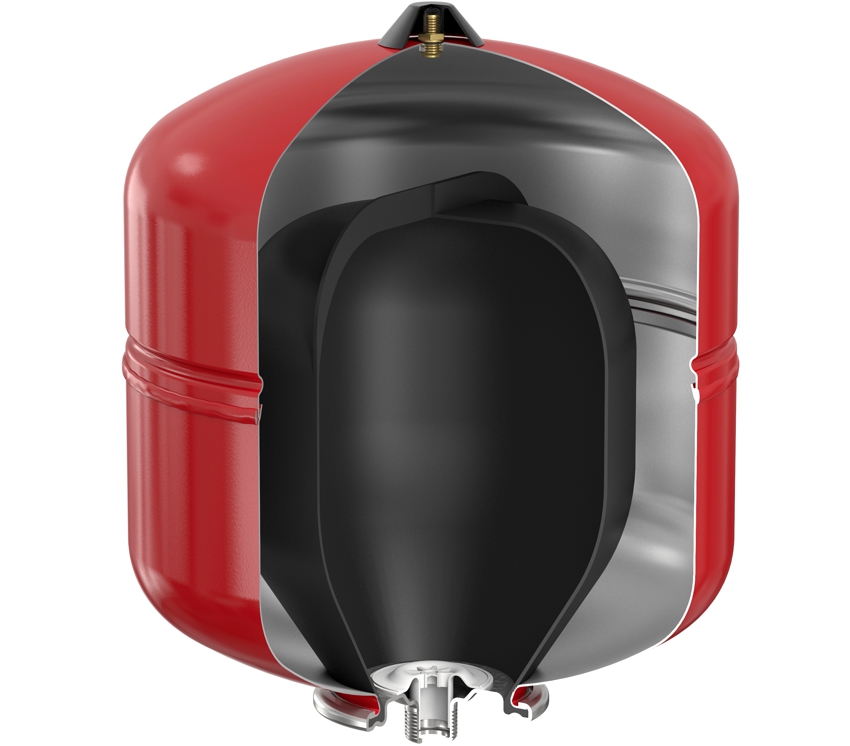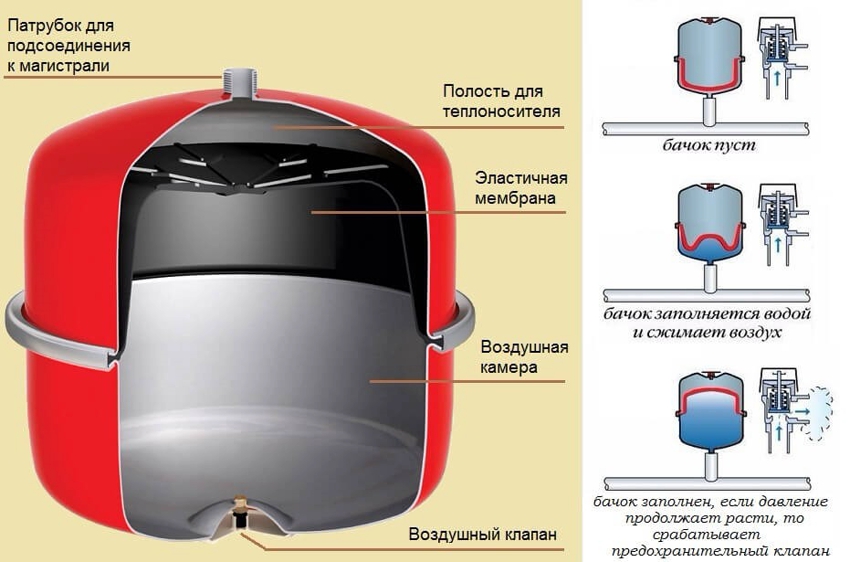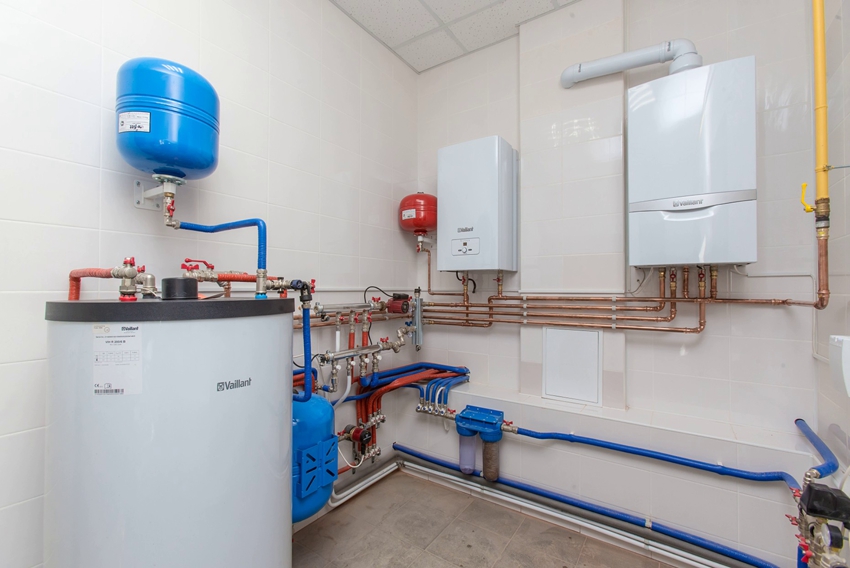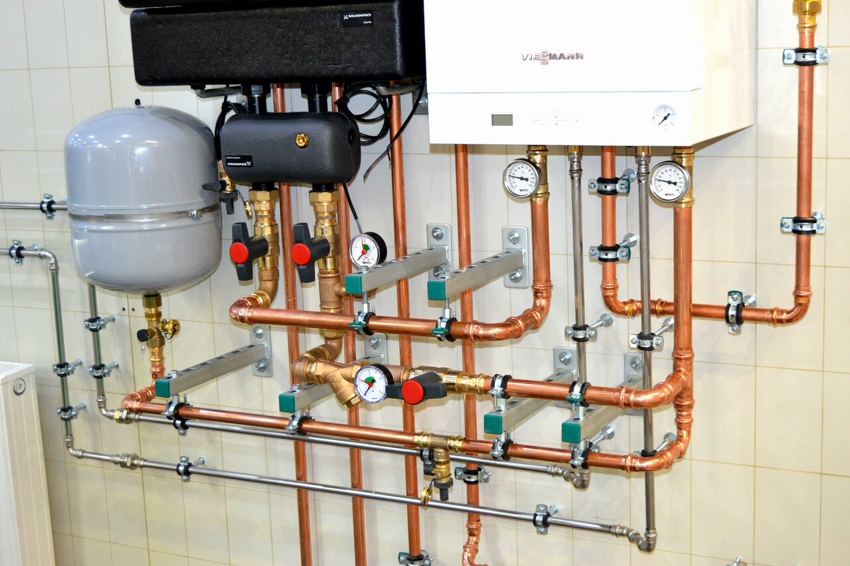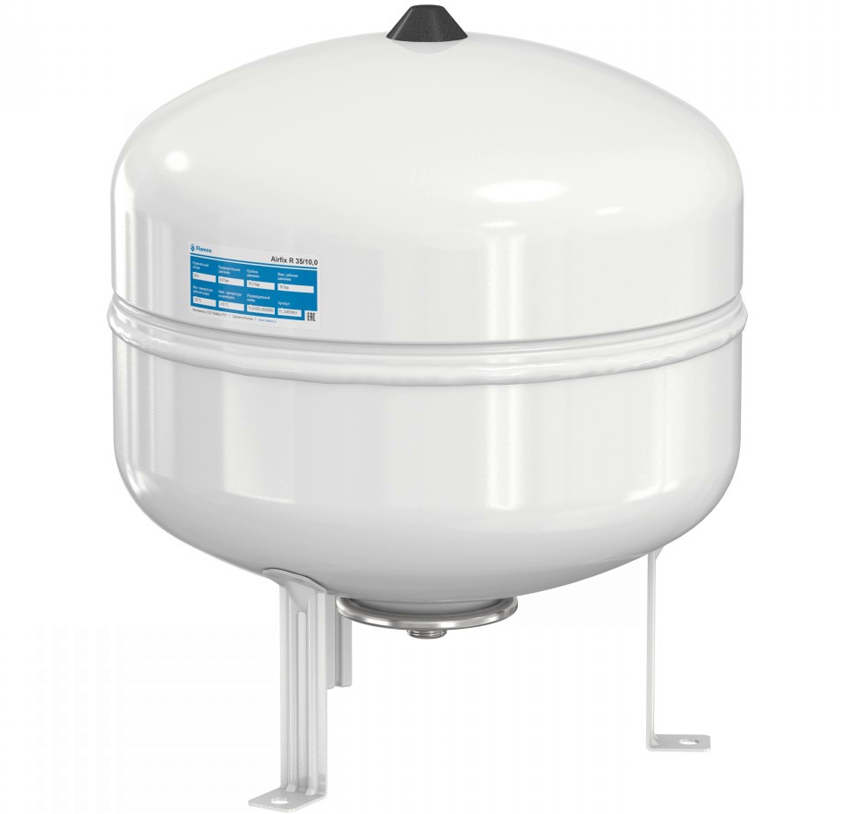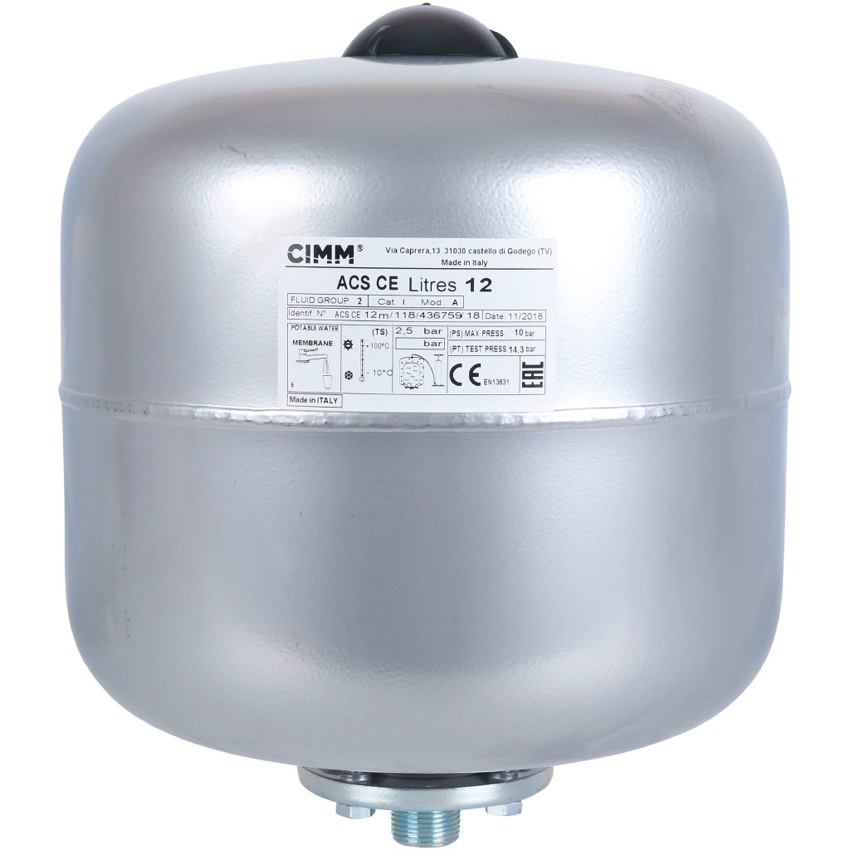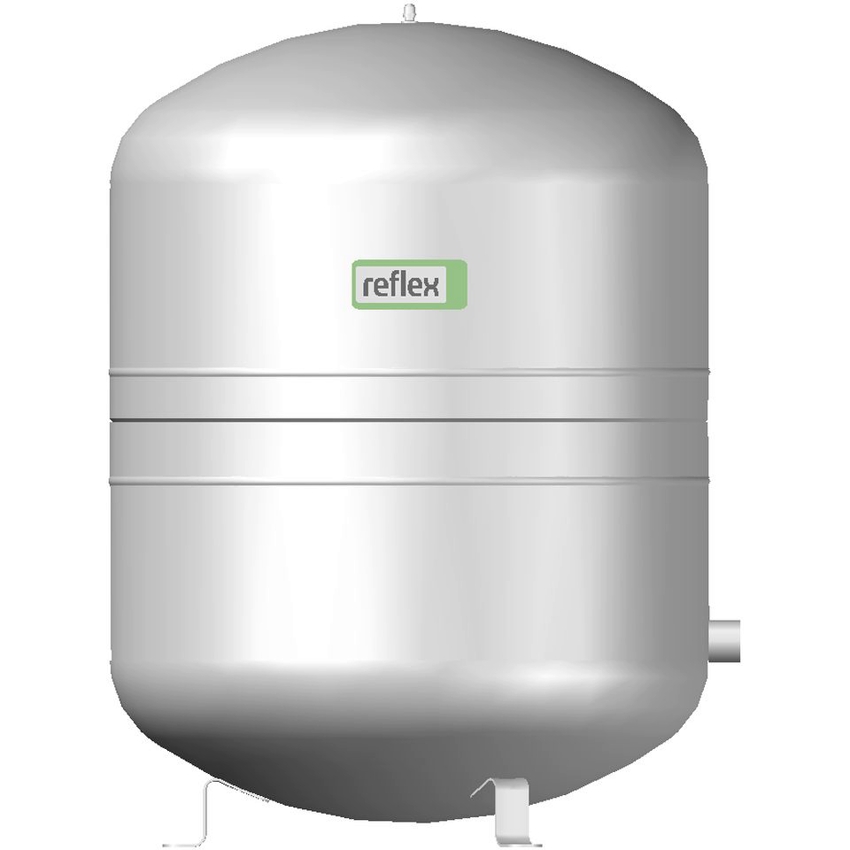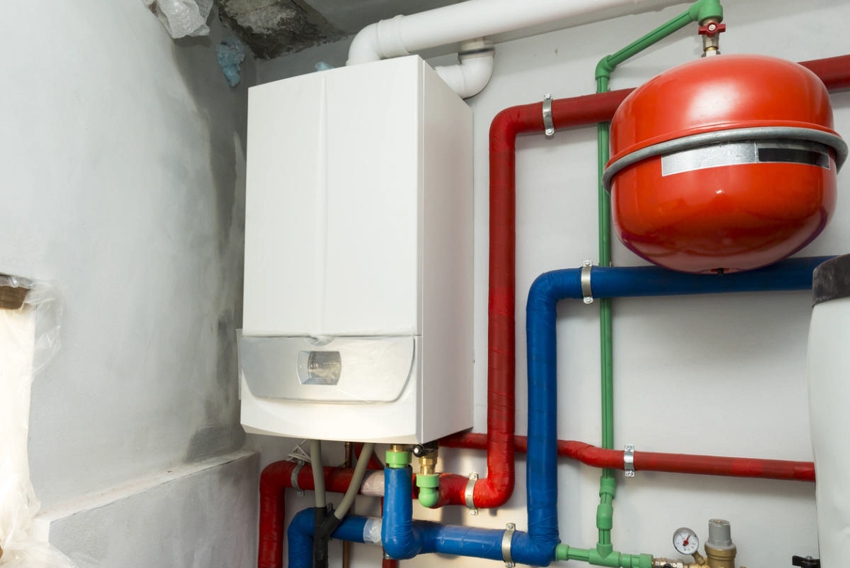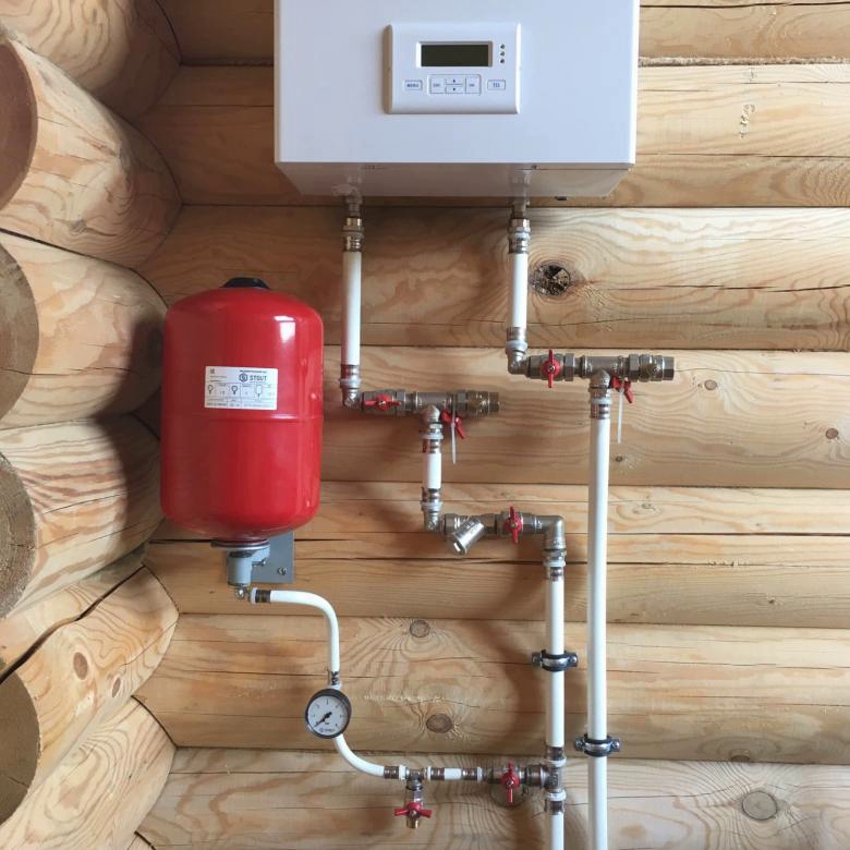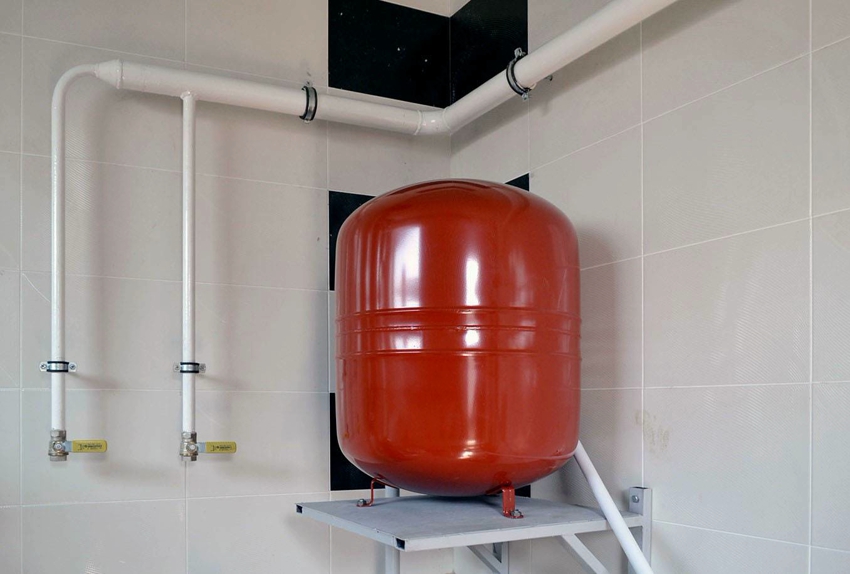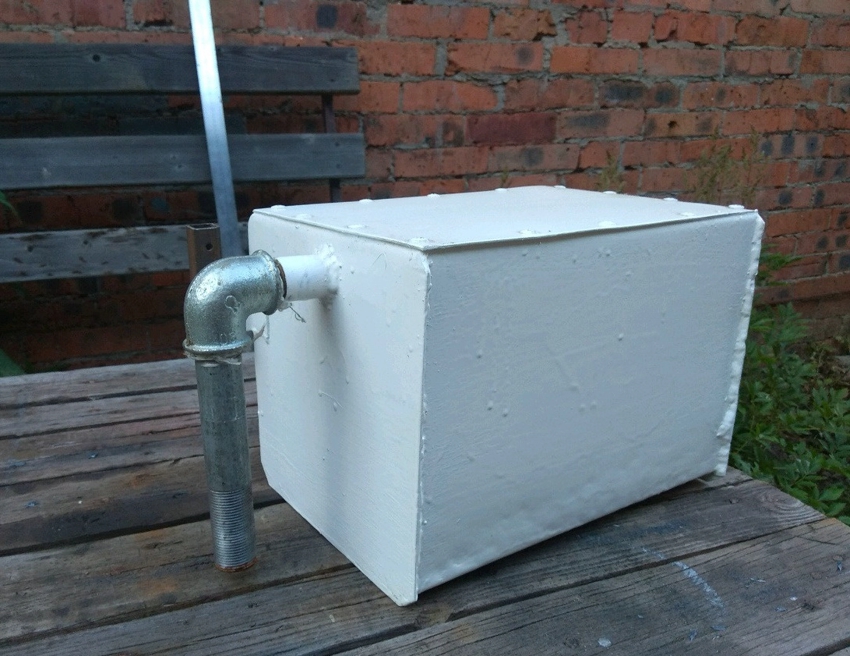To ensure the uninterrupted movement of the coolant, excluding leaks and pipe rupture, an open-type expansion tank for heating is used, or a closed container. The device is designed to compensate for excess liquid as a result of its expansion, which occurs when water is heated. The criteria for choosing a container and the features of installing a tank can be found in this article.
Content [Hide]
- 1 Purpose of the expansion tank for water
- 2 Expansion tank for open-type heating: device characteristics
- 3 Features of the expansion tank for closed type heating
- 4 Heating safety group with expansion tank
- 5 How to choose an expansion tank for heating
- 6 How to install an open-type expansion tank
- 7 Rules for installing a closed expansion tank
- 8 How to make an expansion tank for open-type heating with your own hands
Purpose of the expansion tank for water
The expansion tank for the boiler is an indispensable element of the heating system, which protects it from damage. They can arise as a result of an increase in pressure and volume of the coolant, which occurs when it is heated.
When the temperature of the liquid in the system rises during its circulation, the volume of the coolant increases by 4-6%. This is a rather large value, which can cause a powerful water hammer, since there is no free space to collect excess fluid in the system from pipes and radiators. To accumulate it, an expansion tank is used, where the coolant cools down and returns to the system again. This is necessary to replenish its full volume.
Important! In case of liquid evaporation, it is necessary to replenish its supply in the system.
If a water hammer occurs, breakage of radiators, fittings, pipe rupture and gasket extrusion can occur, which will require expensive repairs. The expansion tank is available in two types: open and closed. In the first case, the structure is represented by a one-volume container that communicates with the atmosphere. An expansion tank for an open-type heating system is installed at the highest point of the system, which will ensure a natural return after cooling of the excess coolant back to the network.
Expansion tanks of a closed type are represented by sealed vessels, in which one part is filled with gas or air, which is under a certain pressure, and the other with liquid.When heated, the coolant enters the expansomat, while compressing the gas. After the liquid has cooled, it is returned to the system, and the difference in volumes is compensated for by gas.
The expansion tank must be installed in heating systems that are mounted on large areas, which are characterized by a significant volume of liquid. Also, an expander is necessary for long pipe lengths to control the pressure in the system. The tank must be installed when using a gas boiler, since the gas heats up the coolant strongly, which contributes to a rapid increase in internal pressure.
Expansion tank for open-type heating: device characteristics
An open expansion tank for heating has a simple design in the form of a rectangular or cylindrical vessel, equipped with a cover that prevents dirt particles from entering the system. The expander must have a branch pipe to which the pipe from the heating system will be supplied. The tank must also be equipped with a drain valve, which will be needed to drain the liquid into the sewer, in case of its accumulation in large volumes.
For safe operation, the expansion tank must have an overflow pipe to drain excess water into the drain network in the event of an overflow of the tank. Also, a water supply pipe must be connected to it to replenish the heating system with water.
Important! Only ordinary water can be used as a heat carrier in a heating system with an open-type expander, since modern antifreezes evaporate quickly, which will require constant replenishment of the liquid and increase heating costs.
Expansion tanks for open-type heating can be made of any material. It can be sheet steel, stainless steel or plastic. The main condition is that it must be heat-resistant, since the coolant is heated to high temperatures.
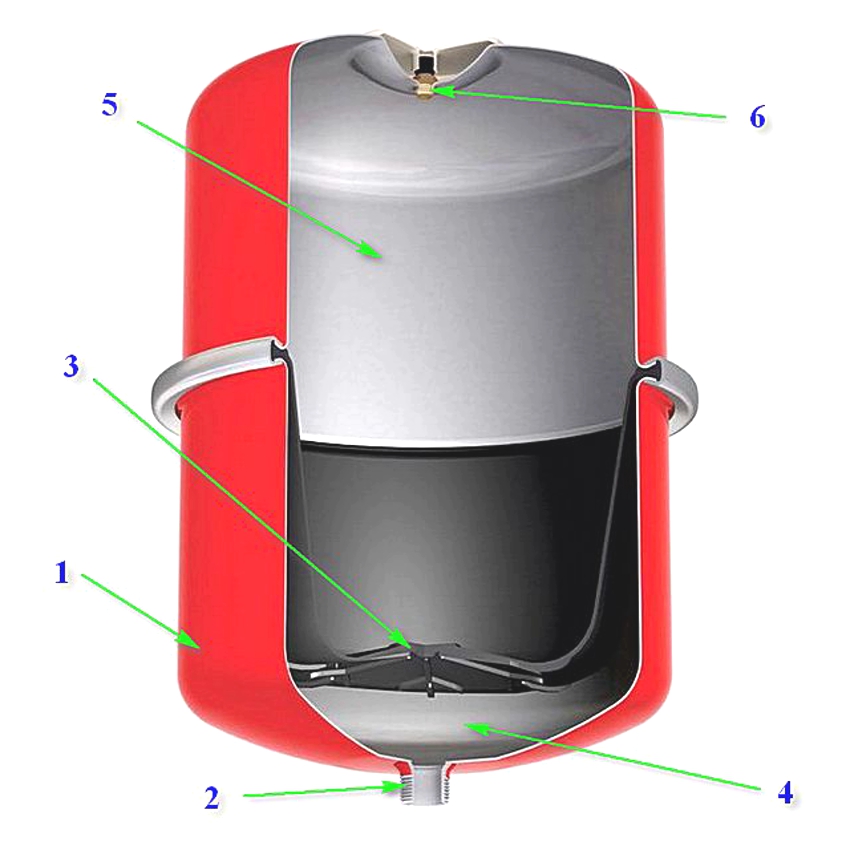
The structure of the expansion tank of the membrane type: 1 - metal body, 2 - branch pipe, 3 - membrane between two chambers of the tank, 4 - chamber filled with coolant, 5 - air chamber, 6 - nipple
Important! Metal containers should be coated with an anti-corrosive compound to prevent premature destruction of the container.
The principle of operation of the expansion tank of the heating system
The principle of operation of the tank is as follows. A liquid heated to a significant temperature begins to increase in volume, thereby increasing the pressure in the system. Excess liquid is squeezed out into the expansion tank, where it will remain until it cools down, after which it will return by gravity back from the heating system. This process is performed cyclically.
The expansion tank for an open heating system is equipped with several nozzles:
- to connect the expansion pipe through which the coolant flows;
- for a circulation pipe that drains water from the system;
- a control pipe designed to adjust the filling of the system and
- elimination of air from it;
- overflow pipe to remove excess liquid.
The design also provides for a spare branch pipe with a tap through which water is discharged during system repair.
If the liquid reaches the maximum level, water will flow through the overflow pipe into the sewer, if connected to it. If a branch pipe with a tap is installed on the overflow, it is necessary to periodically check the water level in the tank by simply opening the stop valves. When installing an expansion tank for heating, it can be equipped with high and low level relays, which can give an audible or light signal when the liquid reaches the maximum level at the overflow point, or the minimum.
Since the expansion tank is not sealed, part of the liquid, coming in contact with air, evaporates, which requires compensation for the normal operation of the system. This happens with the direct participation of a person who must control the volume of water in the system and, if necessary, replenish it.
Advantages and disadvantages of an open expander
The main advantages of the expansion tank of an open-type heating system are the simplicity of the design and complete autonomy of the device, the operation of which does not depend on the performance of the system. All processes in it take place according to the natural cycle, without the use of pumping and other equipment. Also pleasing is the affordable price of an expansion tank for open-type heating, which starts at 1500 rubles.
The disadvantages of such a capacity include:
- the need for thermal insulation of the tank to reduce heat loss;
- installation of additional pipelines, which spoils the aesthetic appearance;
- not tightness of the tank;
- the need for periodic replenishment of water in the system as a result of liquid evaporation. Since water is in direct contact with air, this can cause corrosion of the steel container, which will lead to a decrease in heat transfer, the appearance of noise and a decrease in its service life.
Useful advice! It is advisable to use an open-type expansion tank in a heating system for small areas, no more than 100 m², while the building should be one- or two-story.
In a private house, an open-type heating expansion tank is installed in the attic, staircase or specially equipped box, which is installed on the roof of the house. With a sufficient height of the building, it can be located inside the living quarters in a bathroom or utility room.
Important! If the expansion tank is installed outside the heated part of the house, the tank should be additionally insulated, which will help reduce heat loss in the system.
Features of the expansion tank for closed type heating
The closed-type expansion tank is a sealed vessel made of steel. It is partially filled with liquid and partially inert gas, which is pumped through a special valve. Closed expanders, depending on the variant of dividing the internal volume, are membrane and membraneless.
In membraneless containers, mechanical separation of space is not provided, therefore the coolant is in direct contact with the gas. To maintain the pressure within the specified range, when connecting the expansion tank, a gas cylinder or compressor is used, which is located outside.
Note! Gas supply and pressure control in the system are carried out automatically.
Most modern closed-type expansion vessels are equipped with flexible butyl or EPDM diaphragms that separate the interior of the vessel. They can be disc-shaped or pear-shaped. In the first case, the membrane has the shape of a hemisphere and is attached in the middle of the tank. Depending on the temperature of the coolant, it can take on a concave or convex configuration.
The pear-shaped membrane, repeating the shape of the vessel, is attached to opposite ends of the tank. In this case, the coolant entering the vessel does not come into contact with the walls of the cylinder. It fills a flexible membrane, and the space between it and the tank walls is filled with gas. This feature of the internal structure eliminates the likelihood of corrosion and contributes to an increase in the service life of the device.The price of expansion tanks for closed-type heating with a pear-shaped membrane will be higher than with a disc-shaped membrane, and starts from 3.5 thousand rubles.
Note! The pear-shaped diaphragm can be replaced with a new one, but the belleville diaphragm cannot be replaced.
The advantages of membrane tanks include compact dimensions, minimal heat loss, which eliminates the need for thermal insulation, the ability to work at elevated pressure, minimal risk of corrosion on the walls of the device, durability. Among the disadvantages, it is worth highlighting the high cost, the need to periodically pump gas into the system, and control the pressure in it.
DHW expansion tank
In the hot water supply system, which is provided by a boiler connected to the boiler, an expansion tank is provided for. Its main task is to maintain the working pressure in the network. The expansion tank protects the water supply system from water hammer, protects the pump from increased loads, protects it from breakdowns.
For hot water supply, a closed-type tank with a pear-shaped membrane is used, which divides the internal space into two parts: air and water. It can be made from rubber, artificial or natural rubber. The first two options have high performance properties. Both materials withstand different temperatures of the coolant, up to a boiling state, without losing their original characteristics. Natural rubber diaphragms react negatively on contact with hot water.
The expansion tank is selected based on the amount of excess water that will flow into it when the pressure in the system rises. Experts advise choosing a tank with a volume of 10% of the volume of a hot water boiler. The DHW tank is mounted between the boiler and the valve, which prevents the return flow of hot water to the cold water supply system. The price of the expansion tank starts from 2.2 thousand rubles.
Heating safety group with expansion tank
For a heating system with an expansion tank, the safety group is represented by a set of units that perform a protective function. It consists of three separate instruments that are combined in a special manifold. The group includes a pressure gauge, an air vent and a safety valve.
The pressure gauge is designed to control the pressure of the coolant in the system in order to maintain it at a safe level. It is equipped with two arrows: one shows the working pressure, the other - the set pressure. An air vent in the form of a Mayevsky cock, which operates in automatic mode, is used to remove air bubbles from the liquid in the heating system. It is mounted at the highest possible height. The safety valve is used to control the pressure indicators in the network. If it increases sharply, the valve opens, which helps to remove some of the liquid from the system.
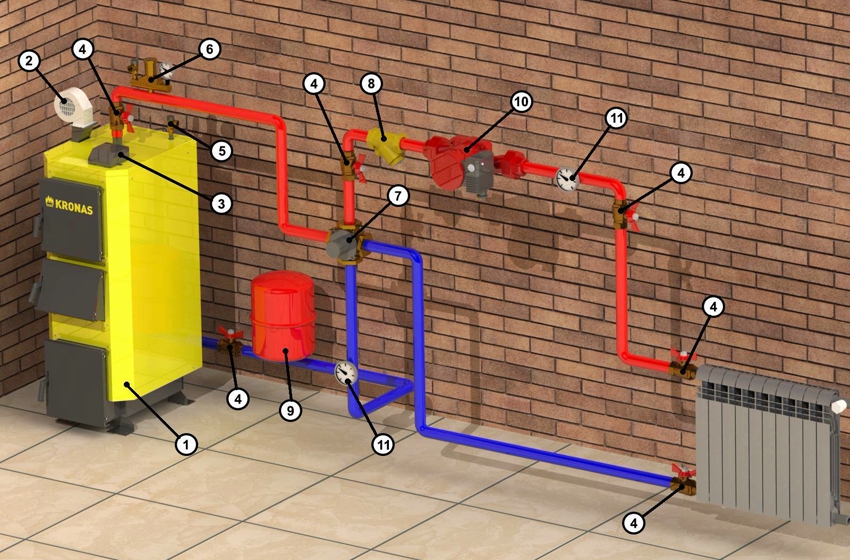
Safety group for heating: 1 - solid fuel boiler, 2 - fan, 3 - shut-off valve, 4 - safety group, 5 - overpressure relief valve, 6 - circulation pump, 7 - filter, 8 - expansion tank, 9 - check valve
The principle of operation of the security group is as follows. When an emergency occurs in the heating system, which leads to the cessation of the movement of the coolant, the pressure in it rapidly increases. Part of the steam from the hot liquid is captured by an air vent, which is equipped with a special float. He goes down and opens the valve. The steam is quickly discharged to the outside, which helps to reduce the pressure in the system.
In the case of ineffective operation of the Mayevsky valve, which contributes to a further increase in pressure, a safety valve is triggered, which opens, allowing the fluid to drain from the system until the pressure stabilizes. The protective block is mounted on the supply pipe, at a distance of more than 50 cm from the heat source. The air vent is installed exclusively in a vertical position. A flexible hose can be connected to the safety valve, through which water will be poured in case of an emergency.
Related article:
Heating meter in an apartment: the best way to save money
Where to install and which option to choose. The main advantages of using. Features of installation and the legal side of the issue. Appliance cost.
How to choose an expansion tank for heating
To ensure safe operation of the heating system, it is important to select the correct expansion vessel. The capacity is selected based on the required volume of liquid that will circulate during the operation of the system. For this, the expansion vessel for heating is pre-calculated. The next criterion is the body material and its coating, which must be resistant to corrosion.
When choosing closed-type tanks, special attention should be paid to its main working part - the membrane. The instructions for the tank indicate what material it is made of, for what pressure and temperature range it is designed.
Useful advice! It is better to choose expansion tanks, which have the possibility of replacing the membrane, which will simplify and reduce the cost of repairing the device.
It is also worth paying attention to the weight of the expansion tank. This indicator will indicate the reliability of the tank and the duration of its operation.
Expansion tanks of closed type can be oval or rectangular. The latter option is more compact, so it will take up less free space, which is especially important for cramped conditions. You should also take into account the design of the tank, which will determine the installation option. Tanks on metal supports are considered the easiest to install, which do not require additional fastening.
Note! For membrane tanks for heating systems, the body is painted red, and for hot water supply it is blue.
When choosing a container, you should give preference to models from well-known manufacturers who have proven themselves on the market with their best side. You should also pay attention to the price of the expansion tank for heating. The cheaper options are less reliable and less durable.
How to calculate an expansion tank for heating
For long-term operation of the heating system and its uninterrupted functioning, it is important to correctly calculate the volume of the expansion tank for heating. Since open-type containers have a simple design, it is quite simple to select the required dimensions. For a more accurate result, you can use special formulas, which must be used when calculating an expansion tank for closed-type heating.
To perform calculations, it is necessary to know the volume of water in the heating system, the temperature regime and the coefficient of linear expansion of the liquid when it is heated to a certain value, which is given in a special table. In addition, you must take into account the safety factor, which is 1.2.
The increase in the volume of water in the system is calculated as the product of the total volume of the liquid and the coefficient of volumetric expansion depending on the change in temperature from the initial to the maximum value. An easier way is to roughly calculate the volume of the expansion tank for heating. For this, 10-12% of the total volume of liquid in the heating system is determined.The resulting value will be the minimum volume for the expansion tank.
Useful advice! It is possible to determine the amount of water in the system at the design stage by adding up the volumes of all components of the system, or empirically, draining all the water from the system and refilling it using a meter or container of a known volume.
It should be remembered that the durability of its operation depends on the correct calculation of the expansion tank for a closed heating system. A tank that is too small in volume will break the safety valve, which will operate frequently. Too large capacity will require sufficient installation space and additional financial costs.
Best Diaphragm Expansion Tanks
An ideal option for a private house heating system will be the Jileks 100 expansion tank, with a capacity of 100 liters, designed for a maximum operating pressure of 6 bar. The body is made of 1 mm thick steel. Phosphate paint coating reliably protects it from corrosion. The tank is installed vertically on three support legs. This model is capable of working with surface and submersible pumps. The cost of the tank is 6900 rubles.
No less popular among consumers is the Reflex NG 100 expansion tank for heating, with a capacity of 100 liters. It has a metal body with a pear-shaped rubber membrane inside. Expansion tank Reflex is designed for a maximum operating pressure of 6 bar and a temperature range of 0-70 degrees. You can buy this model for 5500 rubles.
The Wester WRV 50 expansion tank from the Russian manufacturer is distinguished by its high build quality, a wide temperature range from -10 to 100 degrees, in which it can work. The capacity is designed for 50 liters. The maximum working pressure is 5 bar. The tank can work with ordinary water and antifreeze with a glygol concentration of 50%. The body is made of carbon steel and epoxy-polyester coated. Inside is a monomer membrane. You can buy a tank from 3800 rubles.
A good model is the Stout STH-0006-000050 expansion tank, with a volume of 50 liters. The maximum working pressure is 6 bar, the temperature range is from -10 to +100 degrees. The tank body is made of carbon steel, inside of which there is a pear-shaped membrane made of natural rubber and butyl. The tank is installed on metal supports. The cost of the model starts at 3200 rubles.
How to install an open-type expansion tank
The general scheme of a heating system with an open-type expansion tank consists of a heating boiler, radiators, pipelines and a tank. To install the tank, the highest point of the house is selected, so that the tank rises above all the constituent elements and nodes of the heating system. If the tank is located in an unheated place, its body should be reliably insulated to exclude the possibility of water freezing.
There are several installation options: supply, return, and combined. In the first case, the tank is located above the boiler. This classic version assumes the flow of the coolant not only along the contour, but also its penetration into the tank, where a characteristic noise is created, reminiscent of water boiling in a kettle. Installing a tank on the return line eliminates boiling problems that arise as a result of a reduced liquid temperature.
The combined installation option involves the installation of two expansion tanks. One will be located at the point where the fluid is supplied, and the other on the return. This arrangement will avoid the formation of air pockets in the system. After choosing the installation option, the expansion tank for heating is selected.
The tank is placed on a clean, level surface. It is connected to the heating system by means of couplings with threaded connections or steel pipes by welding. The connection between the tank and the boiler must be made using a vertical pipe. The pipe connecting the tank to the system and the outlet line should be insulated.
Rules for installing a closed expansion tank
The installation of the diaphragm expansion tank must be carried out strictly according to the instructions. The container must not be disassembled or opened beforehand. The tank is mounted in any convenient place, comfortable for service and adjustment. The capacity is installed before branching the system.
Important! Expansion vessels with a volume exceeding 30 liters must be installed on support legs and not fixed to the wall.
According to the instructions, all communications are connected to the expander. After it, a pressure gauge should be mounted. A check valve must be installed at the inlet to the tank.
Many people recommend installing an expansion tank for heating so that the supply pipe is on top and the air chamber is on the bottom. In this case, it will be easier for air to escape from under the membrane. However, experienced specialists insist that the tank should be positioned so that the inlet pipe is at the bottom. This option will extend the period of operation of the tank in case of damage to the membrane, since air will penetrate into the coolant more slowly.
Useful advice! The supply pipeline and the crane should not overload the container with their weight, therefore separate fasteners should be provided for them.
How to make an expansion tank for open-type heating with your own hands
For the manufacture of a plastic expansion tank for open-type heating, you can use a plastic container of the required volume. However, a more reliable option would be a container welded from stainless steel sheets 2-4 mm thick.
First of all, using a grinder, you need to cut out structural elements of a given size. For the body of a homemade expansion tank for open-type heating, you will need 5 parts and one more for the cover. The cut workpieces are welded to each other at right angles using electric welding. A hole should be made in the bottom of the tank, where a branch pipe will be welded to connect the falling pipe.
In addition to the main pipe, a connecting element should be welded to the expansion tank for heating with your own hands to feed the system. It is also necessary to provide a branch pipe for emergency drainage of excess liquid, which must be above the maximum filling level of the container, which will exclude the possibility of overflow of the coolant when filling the tank.
Useful advice! To prevent the coolant from evaporating from an open container, add a little oil to the container, which will tighten the surface of the liquid with a thin film.
Before installing a homemade expansion tank, its walls should be pre-insulated. To do this, you can use basalt wool, which is characterized by resistance to high temperatures.
The expansion tank is an important part of the heating system. The correct choice of capacity and proper installation is a guarantee of durable and trouble-free operation.
